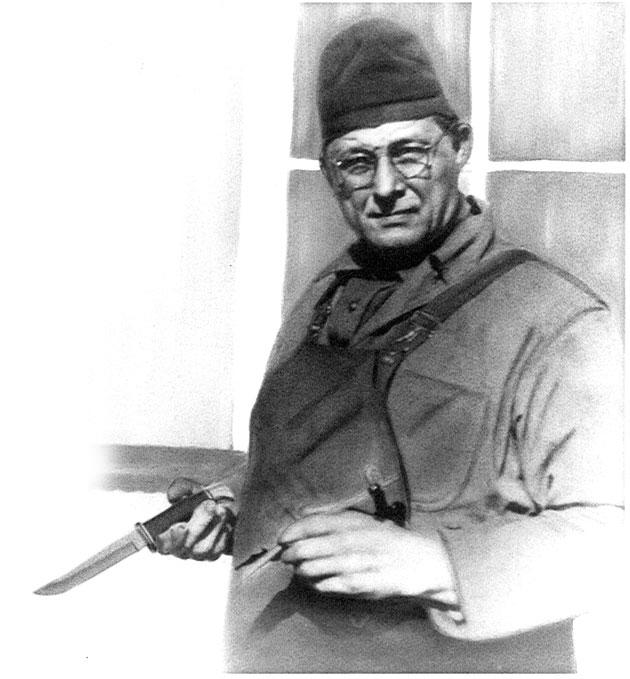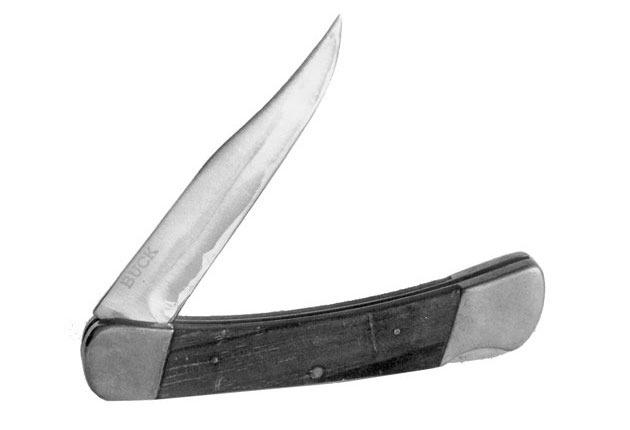From the May/June 2015 issue of Sporting Classics.
It all began with a 10-year-old boy in Kansas who wondered why some hoes and axes needed sharpening more often than others.
Apprenticed out to a blacksmith at the age of 10, Hoyt Buck had an active and inquiring mind that belied his fourth-grade education. When assigned to sharpen hoes and other farm equipment, he noticed that some implements had to be sharpened more often than others, so he began to wonder how metal might be treated to make it tougher and better able to hold its edge.
Of course, the basic idea of plunging heated metal objects such as spears and knives into various liquids to harden them had been around for at least two millennia but the process was considered more magical than scientific. Bull urine was rated highly, and Roman gladiators back in the time of Christ preferred tempering their red-hot swords by running them through recently captured prisoners—the higher the rank and braver the captive, the better the sword.
By the time he was 13 Hoyt had figured out that different steels needed to be heated to different temperatures and then cooled in different ways to produce the best results. The basic implement steel of the day, for example, needed to be heated in the forge until it was the color of butter right before it melts and then plunged into ice-cold water.

Hoyt Buck was looking for a better way to temper steel when he handcrafted the first Buck knife in 1902.
In what little spare time the young apprentice was allowed, he continued to experiment with knives he’d ground down from worn-out files and rasps. These quickly became popular with local people but there the idea stopped, at least until the eve of America’s entry into World War II four decades later.
In 1917 Holt left Kansas for the Seattle-Tacoma area where he found work as a salesman, then as a street car conductor, and finally as a deck hand with a boat on Puget Sound. There, he met Daisy Green who became his wife and mother of his seven children, the oldest of which was Alfred Charles who became known as Al.
Al had his father’s knack for selling, making friends, and working hard, and also a bit of wanderlust. Convincing his mother to bump his 16 years up to 17—probably the only lie she ever told—he joined the Navy. Four years later Al took his discharge but quickly realized the middle of the so-called “Great” Depression was a less than advantageous time to be a young sailor seeking civilian employment. So, back to sea he went, this time with the US Coast Guard based in New York City where he met and married his wife, Ida June, much to the chagrin of her father who considered Al beneath the social class of his daughter. Shortly thereafter Al got orders for San Diego, so he and Ida June put a continent between themselves and the young couple’s disapproving in-laws.
Back on the street as a civilian in 1935, Al found work in a southern California meat-packing plant but nearly lost his left hand while cleaning a meat grinder. After what he considered little less than a miracle Al recovered and landed a job driving a bus for the city of San Diego.
Re-enter Hoyt Buck.
Right after the Japanese bombed Pearl Harbor and America entered World War II, a shortage of sturdy, fixed-blade fighting knives for the troops caused the government to issue a call for Americans to donate their knives. Hoyt didn’t own any suitable knives, but he remembered how to make them. Before long he’d convinced Al, still down in San Diego, to quit his bus-driving job and help build knives. Hoyt and Daisy then pulled up stakes and moved to Southern California—and in with Al and Ida June. Ida June’s reaction to sharing her modest house with her in-laws, somehow or other, has been lost to history.
With the Rising Sun finally snuffed by August of 1945, our soldiers, sailors, and marines began arriving home with memories of those tough Buck knives. Those who hadn’t managed to slip one home in their duffel bags began inquiring about where they could be purchased. So Hoyt and Al incorporated H.H. Buck Knives, a title far fancier than the actual production facility.
Working long hours in a 10- by 12-foot lean-to cobbled onto the side of Al’s garage, Father and son crafted fixed blade hunting knives while continually improving their metallurgy, though production remained both low and slow.
When Hoyt died of cancer in 1949, Al knew he had to either expand the business or get out of it. He knew he had a superior product, but, still, convincing enough folks to pay anywhere from five to ten times what the usual knife cost wasn’t something accomplishable by a few small magazine advertisements. So, in 1961 Al and Ida June loaded camping gear and sample knives into their old and rather wheezy Volkswagen campervan and hit the road.
Their first stop in every town was a telephone booth where they consulted the Yellow Pages for addresses of sporting goods and hardware stores. They visited each store to introduce the proprietor to Buck knives and explain Buck’s “Forever” guarantee. Due mostly to the knives’ heft and undeniable quality, but also to Al’s personality and flattered that the actual president of the company had come by personally, store owners agreed to carry and sell Buck knives.
That year Al and Ida June visited more than 250 stores from sea to shining sea, and while some store owners remained unconvinced, enough signed on to give the company a strong financial footing.
In 1964 Buck introduced the Model 110 Lock Blade Folding Hunter, a knife that solidified the company’s growing reputation for blades of superior strength, quality, and the ability to take and hold an edge. Using only the finest available steel, hefty brass fittings, and hardwood handle, and sticking strictly to Buck’s high quality of production and assembly, the Model 110 quickly won sportsmen around the country. To date, Buck has sold more than 20 million Model 110s.
My personal Model 110 has, during more than 20 years, done everything from geld pigs to have itself pounded with a rock through elk bone and still “cleans up” like a new blade.

The new Brahma Knife represents a unique twist on the company’s popular 119 Special.
This year the Model 110 has been joined by a catalog of about 150 different items, everything from traditional fixed-blade hunting knives to camp axes to kitchen cutlery sets.
Buck’s current president and CEO is C.J. Buck, the fourth generation of the family and a man whose looks and friendly, outgoing and honest attitude fits his role perfectly. Like his forebears, he insists that every knife carrying the Buck name is absolutely the best it can be.
 C.J. Buck
C.J. Buck
C.J. is more than just adamant about Buck quality; he is a visionary who intends to keep Buck continually improving current products and venturing into new lines such as products for anglers, campers, survivalists, and even home chefs.
In late 2004 and early 2005 Buck relocated to a new factory in Post Falls, Idaho, citing California’s unfavorable business climate. (Only coincidentally, C.J. alleges, was the fact that Post Falls is smack dab in the middle of some of North America’s finest hunting and fishing.) California’s loss was a boon of about 400 good factory and administrative jobs for the Idaho town located in the northern-most part of the state, between Spokane, Washington, and Coeur d’Alene.
This year marks Buck’s 10th anniversary in Idaho, which is being celebrated with numerous events as well as commemorative products.
“We want you to be able to rely on our knives over the years . . . like a trusted friend,” says C.J. “After all, when your family name is on a product, you care a lot more about how it works. That has always been the Buck way.”
And will continue to be the Buck way into the firm’s second century, C.J. affirms. His son, Joshua, 29, is active in the company, rising through the ranks, learning the trade, and readying himself to become the fifth generation of the family to spearhead the grand old company.
And to think: It all began with an inquisitive ten-year-old, some dull hoes, and a handful of worn-out files. +++
Be sure to sign up for our daily newsletter to get the latest from Sporting Classics straight to your inbox.
Cover image: The immensely popular Model 110 Lock Blade Folding Knife.

